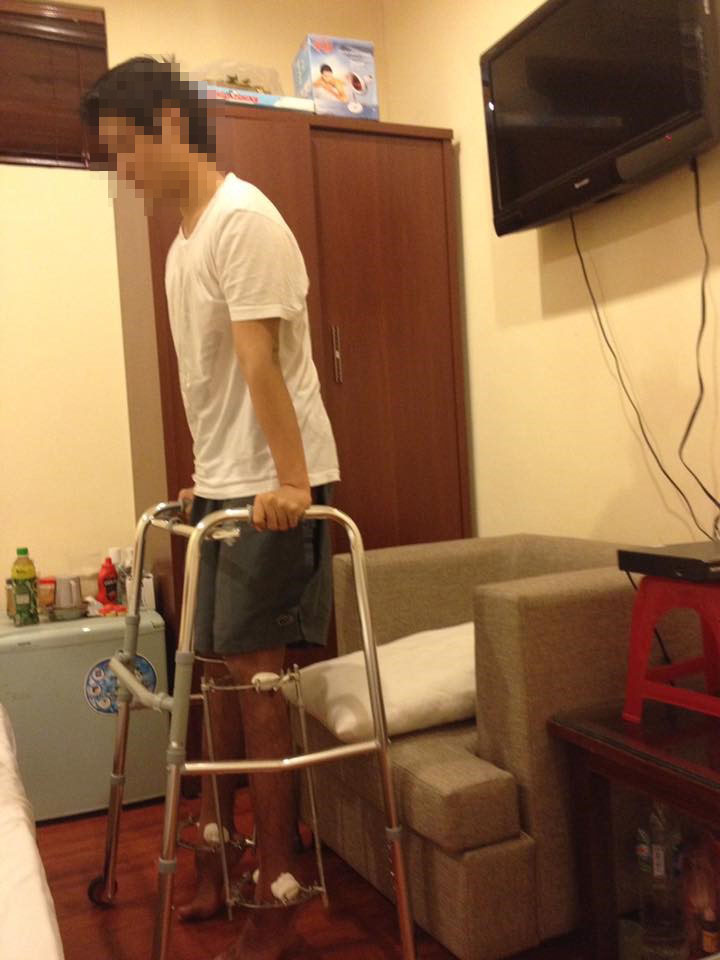
In order for the bone healing process to be eventful, we must follow 4 basic principles:
Fully protect the osteoblasts during the procedure
The osteotomy technique has huge impacts on the quality of the newly-formed bone in the cavity. When performing osteotomy, it is important to preserve the osteoblasts. Osteoblasts consists of periosteum and bone marrow. Periosteum is integral to the filling of cavity and its ability to form new bone is five times faster than of the bone marrow. Therefore, when performing osteotomy using any method (carving, sawing, drilling, etc.), the doctor must commit to fully protect the osteoblasts.
Set suitable stretching rate and pace
The optimal stretching rate for the healing process should be 1mm per day, equally divided to 3-4 times a day. However, the stretching rate should be reduced when the stretched cavity at the diaphysis or at the bone position in general is malnourished, when the soft tissue are poor or when the patient is an elderly.
If the osteogenesis process is bad, the stretching rate should be reduced, or the stretching process should be halted entirely to help improve the osteogenesis process. A suitable stretching rate can also preserve blood supply to the osteoblasts. In the clinical perspective, the waiting period is usually between 7 and 10 days, depending on factors such as age, position of the cut, osteotomy technique, quality of the bone, soft tissue status, etc. The waiting period should be long if the osteogenesis process is bad and vice versa.
Fix the cavity
The firrm fixation of the external fixator is an important factor in the bone healing process. The external fixator should be firm to fix the cavity and only allow the cavity to be elastic along the vertical axis of the bone. If the fixator is not firm, the bone healing process will be slow or it may lead to nonunion. The Ilizarov fixator uses Kirschner nails with diameters ranging from 1.4 to 2 mm that allow not only the cavity to be fixed, but also the cavity to be elastic which stimulates the osteoblasts to have a better growth than from a stiff external fixator.
Exercise the joints and do compression exercises for the limb as soon as possible
Exercising the joints and doing compression exercises for the limb as soon as possible can help prevent amyotrophic diseases, improve muscular strength, prevent joint stiffness as well as improve blood supply to the cavity. Doing compression exercises as soon as possible stimulates the osteogenesis process in the leg lengthening procedure.

A patient that is exercising the joints and doing compression exercises for both legs after the surgery.
Để quá trình liền xương diễn ra thuận lợi khi kéo dài chân thì phải tuân theo 4 nguyên tắc cơ bản:
Bảo vệ tối đa các mô sinh xương khi phẫu thuật
Kỹ thuật cắt xương ảnh hưởng rất lớn đến chất lượng xương mới được tạo ra tại ổ căng dãn mà điểm quan trọng khi cắt xương phải giữ được các mô sinh xương. Mô sinh xương bao gồm cốt mạc và tủy xương. Cốt mạc có vai trò quyết định đối với việc hình thành can xương và khả năng tạo xương mới gấp 5 lần so với tủy xương. Chính vì vậy, khi cắt xương bằng bất kỳ phương pháp nào (đục, cưa, khoan..) thì bác sĩ phải bảo tồn được tối đa cốt mạc.
Tốc độ và nhịp điệu căng dãn phù hợp
Tốc độ căng dãn tối ưu cho quá trình liền xương là 1mm/ngày, chia đều 3-4 lần/ngày. Tuy vậy, tốc độ căng dãn cần giảm khi ổ căng dãn ở thân xương hoặc ở vị trí xương được nuôi dưỡng kém, hoặc khi phần mềm xấu, hoặc ở người cao tuổi.
Nếu quá trình tạo xương kém thì nên giảm tốc độ căng dãn, thậm chí tạm ngưng căng dãn để giúp cải thiện quá trình tạo xương. Tốc độ căng dãn phù hợp cũng bảo tồn sự cấp máu cho các mô sinh xương. Trên lâm sàng, thời gian chờ đợi thường từ 7-10 ngày, phụ thuộc vào: tuổi, vị trí cắt xương, kỹ thuật cắt xương, chất lượng xương, tình trạng phần mềm…Thời gian chờ đợi dài khi nghi ngờ quá trình tạo xương diễn biến kém và ngược lại.
Cố định ổ căng dãn
Việc cố định vững của khung cố định ngoài là yếu tố rất quan trọng cho quá trình liền xương. Khung cố định ngoài phải đủ vững để cố định ổ căng dãn và chỉ cho phép ổ căng dãn đàn hồi theo trục dọc của xương. Nếu khung cố định ngoài không vững thì sẽ dẫn đến liền xương kém hoặc không liền xương. Khung Ilizarov sử dụng các đinh Kirschner có đường kính từ 1,4 đến 2 mm cho phép vừa cố định vững ổ căng dãn, vừa cho phép đàn hồi tại ổ căng dãn, kích thích mô sinh xương phát triển tốt hơn một khung cố định ngoài cứng nhắc.
Tập vận động các khớp và tì nén sớm trên chi mổ
Tập vận động các khớp và tì nén trên sớm chân mổ sớm, có tác dụng chống teo cơ, tăng cường sức cơ, chống cứng khớp, đồng thời tăng cường máu đến nuôi dưỡng ổ can xương. Tập tì nén sớm kích thích quá trình tạo xương trong kéo dài chân.

Bệnh nhân tập vận động các khớp và tì nén trên 2 chân sau mổ

